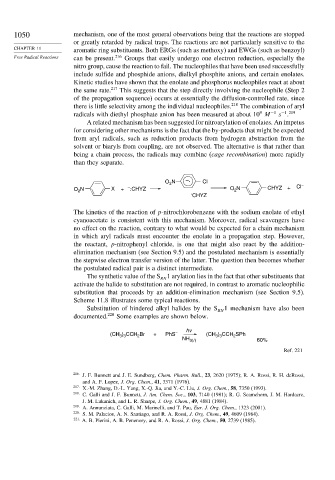Page 1066 - Advanced Organic Chemistry Part A - Structure and Mechanisms, 5th ed (2007) - Carey _ Sundberg
P. 1066
1050 mechanism, one of the most general observations being that the reactions are stopped
or greatly retarded by radical traps. The reactions are not particularly sensitive to the
CHAPTER 11 aromatic ring substituents. Both ERGs (such as methoxy) and EWGs (such as benzoyl)
Free Radical Reactions can be present. 216 Groups that easily undergo one electron reduction, especially the
nitro group, cause the reaction to fail. The nucleophiles that have been used successfully
include sulfide and phosphide anions, dialkyl phosphite anions, and certain enolates.
Kinetic studies have shown that the enolate and phosphorus nucleophiles react at about
the same rate. 217 This suggests that the step directly involving the nucleophile (Step 2
of the propagation sequence) occurs at essentially the diffusion-controlled rate, since
there is little selectivity among the individual nucleophiles. 218 The combination of aryl
−1 219
9
radicals with diethyl phosphate anion has been measured at about 10 M −1 s .
A related mechanism has been suggested for nitroarylation of enolates. An impetus
for considering other mechanisms is the fact that the by-products that might be expected
from aryl radicals, such as reduction products from hydrogen abstraction from the
solvent or biaryls from coupling, are not observed. The alternative is that rather than
being a chain process, the radicals may combine (cage recombination) more rapidly
than they separate.
N –. Cl
O 2 –
O N X + – :CHYZ O N CHYZ + Cl
2
2
.
CHYZ
The kinetics of the reaction of p-nitrochlorobenzene with the sodium enolate of ethyl
cyanoacetate is consistent with this mechanism. Moreover, radical scavengers have
no effect on the reaction, contrary to what would be expected for a chain mechanism
in which aryl radicals must encounter the enolate in a propagation step. However,
the reactant, p-nitrophenyl chloride, is one that might also react by the addition-
elimination mechanism (see Section 9.5) and the postulated mechanism is essentially
the stepwise electron transfer version of the latter. The question then becomes whether
the postulated radical pair is a distinct intermediate.
The synthetic value of the S 1 arylation lies in the fact that other substituents that
RN
activate the halide to substitution are not required, in contrast to aromatic nucleophilic
substitution that proceeds by an addition-elimination mechanism (see Section 9.5).
Scheme 11.8 illustrates some typical reactions.
Substitution of hindered alkyl halides by the S RN 1 mechanism have also been
documented. 220 Some examples are shown below.
hv
(CH ) CCH Br + PhS – (CH ) CCH SPh
2
2
3 3
3 3
NH 3(l ) 60%
Ref. 221
216
J. F. Bunnett and J. E. Sundberg, Chem. Pharm. Bull., 23, 2620 (1975); R. A. Rossi, R. H. deRossi,
and A. F. Lopez, J. Org. Chem., 41, 3371 (1976).
217 X.-M. Zhang, D.-L. Yang, X.-Q. Jia, and Y.-C. Liu, J. Org. Chem., 58, 7350 (1993).
218 C. Galli and J. F. Bunnett, J. Am. Chem. Soc., 103, 7140 (1981); R. G. Scamehorn, J. M. Hardacre,
J. M. Lukanich, and L. R. Sharpe, J. Org. Chem., 49, 4881 (1984).
219
A. Annunziata, C. Galli, M. Marinelli, and T. Pau, Eur. J. Org. Chem., 1323 (2001).
220 S. M. Palacios, A. N. Santiago, and R. A. Rossi, J. Org. Chem., 49, 4609 (1984).
221
A. B. Pierini, A. B. Penenory, and R. A. Rossi, J. Org. Chem., 50, 2739 (1985).

